
Ēdole Castle is a Gothic Revival castle situated on the banks of Ēdole Lake, Ēdole parish, in the historical region of Courland, western Latvia. Originally consisting of two residential buildings linked by a stone wall, the castle is surrounded by landscape park. It is considered an architectural and archaeological monument of national importance.

Kabile Manor is a manor house located in Kuldīga Municipality, Kabile Parish, in the historical region of Courland, in western Latvia.
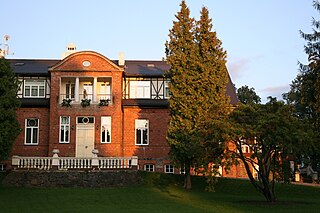
Kalna Manor, also called Sieksāte Manor, is a manor house in Rudbārži Parish, Kuldīga Municipality in the Courland region of Latvia. The complex includes a manor, park and farm buildings.

Sasmaka Manor is a manor house located in a park near Lake Sasmaka west coast, near Valdemārpils, Talsi municipality, in the historical region of Courland, western Latvia.

Snēpele Palace is a palace in Snēpele Parish, Kuldīga Municipality in the Courland region of Latvia. It was originally built at the beginning of the 19th century as a baronial hunting lodge with two room apartments for guests on the second floor. The building has housed the Snēpele primary school since 1924.
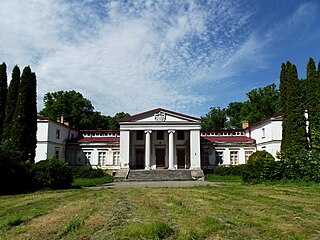
Zentene Palace is a manor house in the historical region of Courland, in western Latvia.

Gārsene Manor is a Neo-Gothic manor house located in Gārsene Parish, Jēkabpils Municipality in the Selonia region of Latvia. The palace houses a museum where visitors can view an exhibition about the Baltic-German von Budberg family.

Jaunpils Castle is a castle in Jaunpils Parish, Tukums Municipality in the Semigallia region of Latvia. More of a manor house than properly a fortified castle, it has now been converted into a hotel.

Lielauce Manor is a manor house built in late classical or Empire style in the 19th century for Count Medem on the south shore of Lielauce Lake, in Lielauce Parish, Dobele Municipality, in the Semigallia region Latvia.
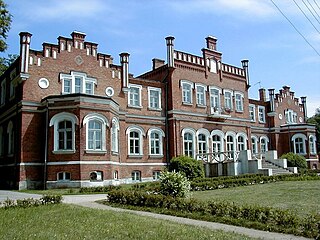
Mežmuiža Manor, also called Augstkalne Manor, is a Neo-Gothic style manor house in Augstkalne Parish, Dobele Municipality in the Semigallia region of Latvia.

Zemīte Manor is a manor house in Zemīte, Zemīte Parish, Tukums Municipality in the Courland region of Latvia. Damaged by fire both in 1905 and 1931, the structure was repaired each time. It currently houses the Zemīte primary school.

Bebrene Manor is a manor house in Bebrene, Bebrene Parish, Augšdaugava Municipality, in the Selonia region of Latvia. Commissioned by Count Stanisław Kostka Plater-Zyberk and built in French neo-Renaissance style in the late 19th century by the Polish-Italian architect Leandro Marconi, the Bebrene Palace complex is located in a park, one of the most expressive landscaped parks of the English style in Latvia.

Blankenfelde Manor is a manor in Vilce Parish, Jelgava Municipality in the historical region of Semigallia, in Latvia. Built at the last quarter of the 17th century, it changed owners several times. The renovation work is currently being processed.
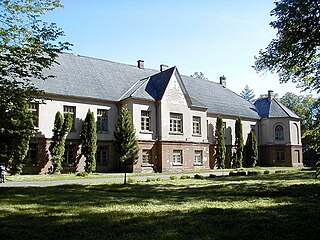
Vāne Manor is a 19th-century manor house in Vāne parish, Tukums Municipality in the Courland region of Latvia.

Vecmēmele Manor is a manor house in Mazzalve Parish, Aizkraukle Municipality in the Selonia region of Latvia.

Cirsti Manor is a two-storey manor house built in 1886 in Neo-Gothic red brick style in the Ineši Parish of Cēsis Municipality in the Vidzeme region of Latvia.

Litene Manor is a manor house in Litene parish, in the historical region of Vidzeme, in northern Latvia. It was built during the first half of the 19th century in Classical style for Baron Otto von Wolff on the banks of the Pededze. Manor was burned down during revolution of 1905 but was later restored in simplified forms. After Latvian agrarian reforms in 1921 manor house was nationalized and lands partitioned. Since 1924, building houses the Litene Primary School. By the decision of the Gulbene Municipality Council, Litene Primary School is closed from September 1, 2018.
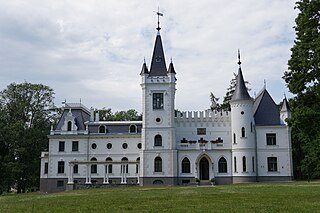
Stāmeriena Palace is a palace built in Historicist style from 1835 to 1843 in the historical region of Vidzeme, northern Latvia. Its first owner was Johann Gottlieb von Wolff (1756-1817) and subsequently his descendants.
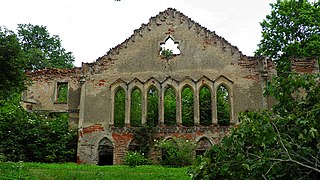
Asare Manor is a manor house built in 1749 in the Asare Parish of Aknīste Municipality,, in the Selonia region of Latvia. The house was built in 1749, rebuilt in the 19th century in Neo-Gothic style, and burned down in 1926. During the Latvian agrarian reforms in 1920, the manor house was nationalized and lands partitioned. Prior to reform manor belonged to the Walther-Wittenheim family. Currently only impressive ruins remain.





















